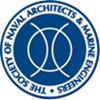模型尺度下船舶流体动力学的壁面模拟LES
IF 1
4区 工程技术
Q3 ENGINEERING, CIVIL
引用次数: 10
摘要
提出了一种完整的壁面大涡模拟方法,用于模型尺度下散货船周围流动的模拟。该方法的基本组成部分是对船体上方湍流边界层(TBL)厚度的先验估计,并使用相对于该厚度具有适当分辨率的非结构化网格。从文献中计算成本的缩放表达式,在网格尺寸方面,与雷诺数,适用于本应用程序。研究表明,WMLES可以用于模型尺度的船舶流体动力学,具有~ 108个网格单元,与壁面分辨LES相比,这至少是一个数量级的增益。以平板TBL为例,研究了壁面模型参数和网格拓扑结构对该方法预测精度的影响。对于平板情况,将WMLES结果与直接数值模拟、reynolds -average Navier-Stokes(雷诺平均纳维-斯托克斯)和半经验公式的结果进行比较。对于散货船流量,比较了WMLES和RANS,但需要进一步验证来评估该方法的预测准确性。本文章由计算机程序翻译,如有差异,请以英文原文为准。
Wall-Modeled LES for Ship Hydrodynamics in Model Scale
A complete approach for wall-modeled large-eddy simulation (WMLES) is demonstrated for the simulation of the flow around a bulk carrier in the model scale. Essential components of the method are an a-priori estimate of the thickness of the turbulent boundary layer (TBL) over the hull and to use an unstructured grid with the appropriate resolution relative to this thickness. Expressions from the literature for the scaling of the computational cost, in terms of the grid size, with Reynolds number, are adapted in this application. It is shown that WMLES is possible for model scale ship hydrodynamics, with ∼108 grid cells, which is a gain of at least one order of magnitude as compared with wall-resolving LES. For the canonical case of a flat-plate TBL, the effects of wall model parameters and grid cell topology on the predictive accuracy of the method are investigated. For the flat-plate case, WMLES results are compared with results from direct numerical simulation, RANS (Reynolds-averaged Navier-Stokes), and semi-empirical formulas. For the bulk carrier flow, WMLES and RANS are compared, but further validation is needed to assess the predictive accuracy of the approach.
求助全文
通过发布文献求助,成功后即可免费获取论文全文。
去求助
来源期刊

Journal of Ship Research
工程技术-工程:海洋
CiteScore
2.80
自引率
0.00%
发文量
12
审稿时长
6 months
期刊介绍:
Original and Timely technical papers addressing problems of shipyard techniques and production of merchant and naval ships appear in this quarterly publication. Since its inception, the Journal of Ship Production and Design (formerly the Journal of Ship Production) has been a forum for peer-reviewed, professionally edited papers from academic and industry sources. As such, it has influenced the worldwide development of ship production engineering as a fully qualified professional discipline. The expanded scope seeks papers in additional areas, specifically ship design, including design for production, plus other marine technology topics, such as ship operations, shipping economic, and safety. Each issue contains a well-rounded selection of technical papers relevant to marine professionals.
 求助内容:
求助内容: 应助结果提醒方式:
应助结果提醒方式:


